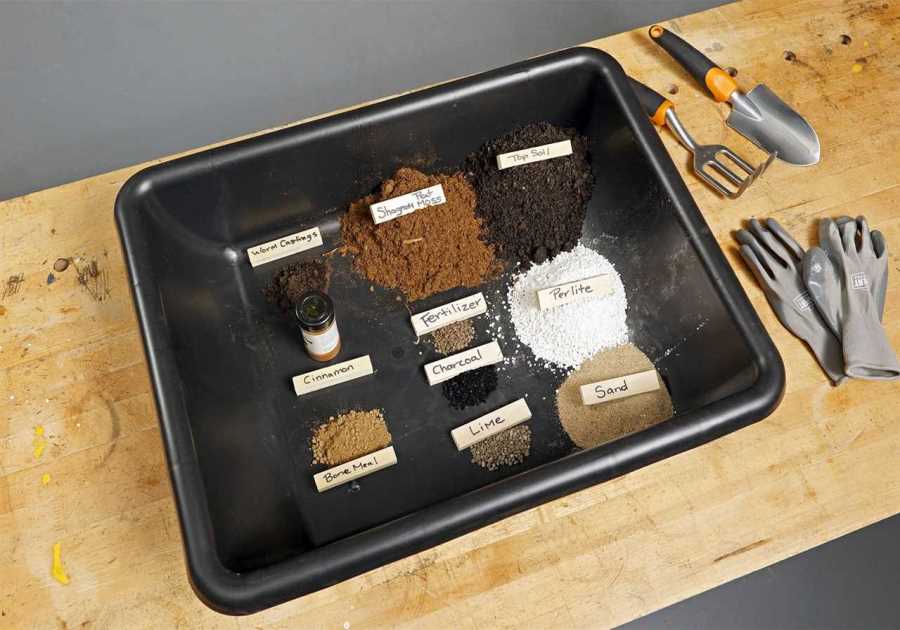When you buy through our links, Business Insider may earn an affiliate commission. Learn more
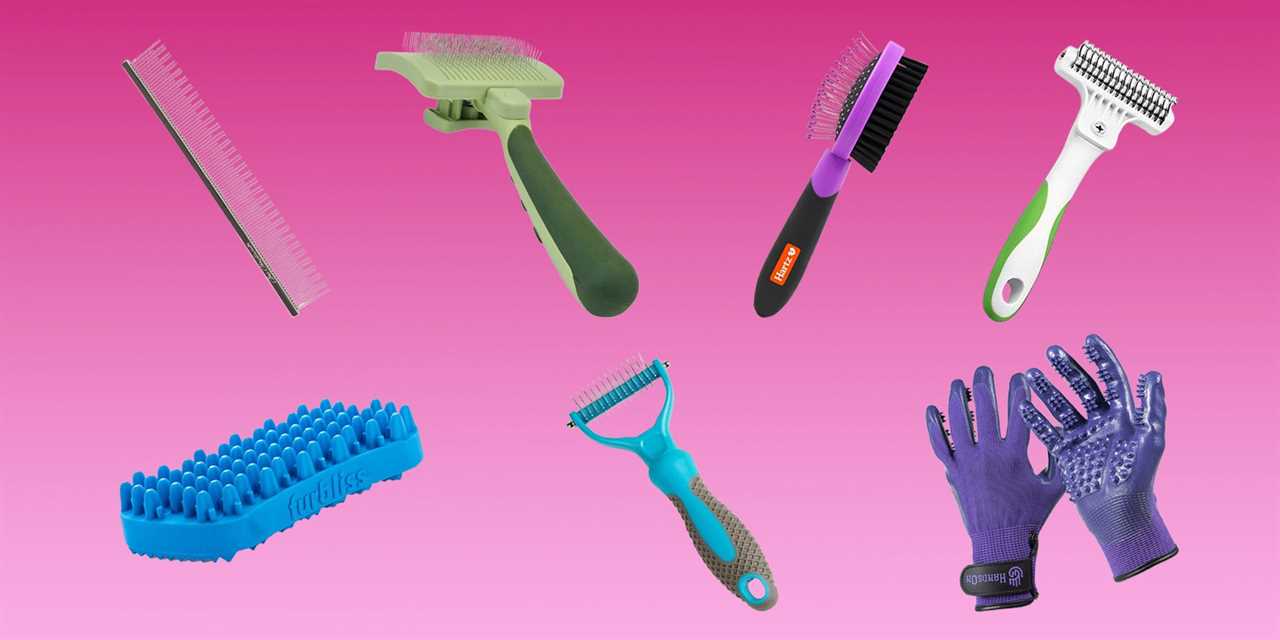
Chewy/insider
The average cat is excellent at self-grooming, spending up to half the day cleaning themselves. However, both long- and short-haired cats can benefit from regular brushing with one of the best cat brushes. Regular grooming with a brush or comb removes loose hair and distributes natural skin oils throughout a cat's coat, says Dr. Aimee Simpson, veterinarian and medical director of VCA Cat Hospital of Philadelphia.
For this guide, we tested 31 different grooming tools with four cats. Our top pick for cats with short or long hair is the Hartz Groomer's Best Combo Brush, a two-sided pin and bristle brush designed for daily use. It removes loose fur, works out small tangles, and smoothes the top coat or delicate hairs on the face.
Read more about how Business Insider Reviews researches and tests pet products here.
Our top picks for the best cat brushes
Best overall: Hartz Groomer's Best Combo Brush - See at Chewy
This dual-sided brush has pins for removing loose fur and small tangles and nylon bristles for smoothing and softening the coat — it's like a massage for your cat and costs less than $10.
Best deshedding: Andis Deshedding Tool - See at Chewy
The hooked teeth on the Andis Pet Deshedding Tool deftly remove hair from a cat's undercoat without irritating the skin.
Best slicker: Safari Self-Cleaning Slicker Brush for Cats - See at Chewy
This slicker brush works well for removing loose fur and small knots and can be cleaned out with the push of a button.
Best comb: Chris Christensen Cat/Carding Buttercomb #013 - See at Amazon
The comb has teeth of two lengths to remove tangles and mats on long-haired cats.
Best dematting tool: Well & Good Prostyle Dual-Sided Shedding Rake - See at Amazon
This two-in-one tool has different types of teeth built into each side of the head so you can easily dislodge mats and remove loose fur.
Best grooming gloves: HandsOn All-In-One Bathing and Grooming Gloves - See at Chewy
These grooming gloves are an ideal way to remove hair, dirt, and dander from cats that are sensitive to grooming and handling.
Best silicone: Furbliss Pet Brush - See at Chewy
This silicone curry brush has gentle nubs for light brushing.
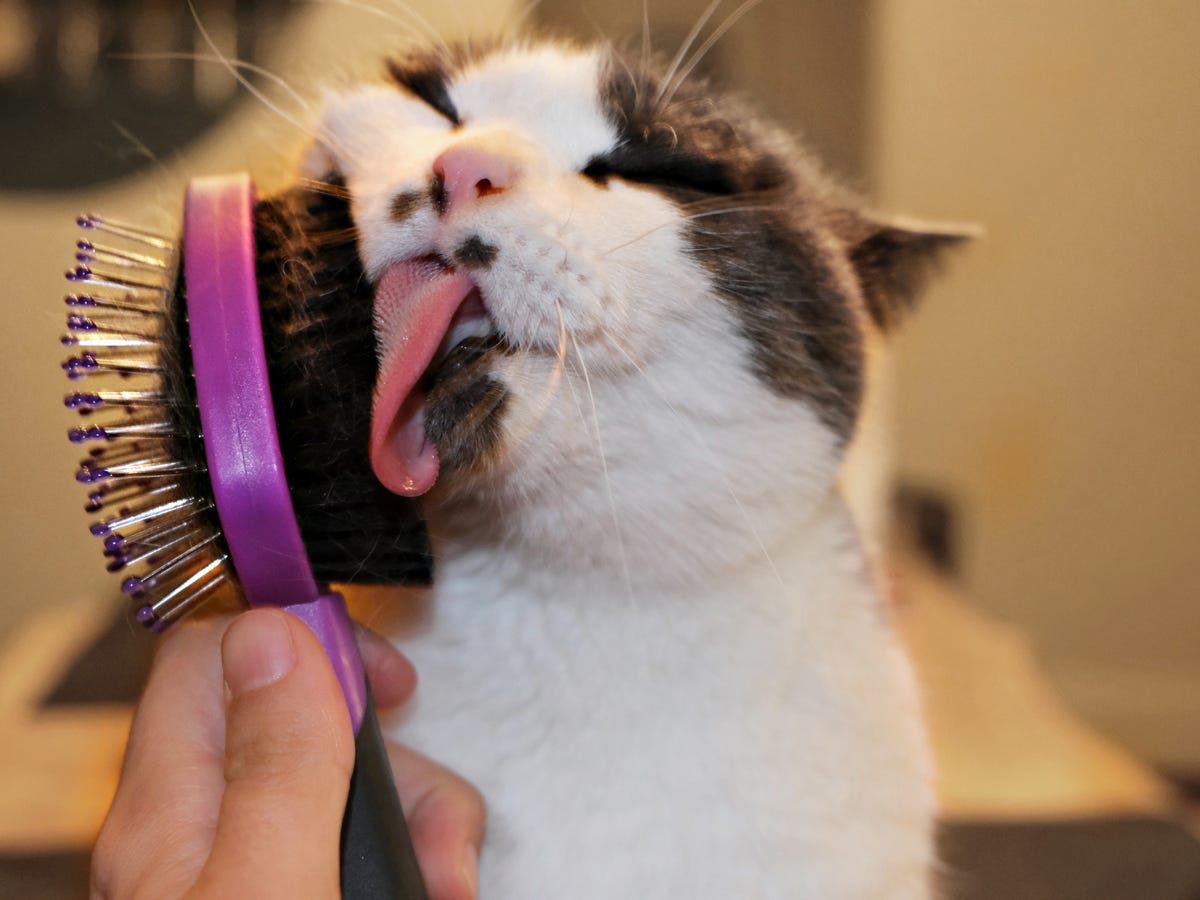
Janelle Leeson/Business Insider
Pros: Easily removes loose fur, reaches undercoat fur while protecting skin from pokes and prodding, soft nylon bristles delicate enough for face and softens top coat, easy to grip, inexpensive
Cons: Cats may chew rubber handle and plastic tips, stainless steel tines may bend if brush dropped
Persuading your cat to sit through a grooming session can be challenging, but the double-sided Hartz Groomer's Best Combo Brush can make the process less taxing and, dare we say, downright enjoyable for cats of all fur lengths and humans alike.
Both gentle yet effective, this combo brush is our go-to for daily use. It features stainless steel pins on one side to remove loose fur and small tangles. The other side has nylon bristles for smoothing and softening the coat. The metal pins gently dislodged loose hair from our long-haired cat's coat, while both the pins and bristles proved ideal for our short-haired cat. Our tester cats particularly enjoyed the bristles around their delicate faces. Although the pins successfully work through small tangles, you'll need a different brush for more substantial knots and mats.
This brush has the safety features that Daniel Lioyryan, a cat groomer at Cats in the City, looks for in pin brushes. The rubber tips on the stainless steel pins provide a massaging effect and protect cats from getting poked, and the soft pad that holds the pins in place is flexible enough to prevent the tines from jabbing a cat. We also found it easy to grip the rubber handle while grooming.

Shoshi Parks/Business Insider
Pros: Easily removes undercoat fur while protecting skin from irritation, lightweight, easy to grip, small enough to reach tight spots, removes more hair than other brushes
Cons: Leaves behind a layer of loose hair, pricey
Lioyryan recommends using a deshedding tool on cats monthly to every other month to remove excess and compacted fur and thin out dense coats. The Andis Pet Deshedding Tool is the most effective tool we tested for both short- and long-haired cats. In just a few strokes, it removes as much, or more, fur than other tools do in an entire brushing session.
The power of the Andis deshedder lies in its curved metal teeth, which reach beneath the topcoat to pull hair from the undercoat. The teeth gently catch hold and remove hair without causing discomfort or irritating a cat's skin. One of our cats absolutely adored being brushed with this tool, and the hooked teeth prevented us from accidentally nicking or over-raking their skin. The tool itself is lightweight, and its handle is easy to grip. The width of the head, about 4.5 inches, is an ideal size to get the job done quickly while still fitting into hard-to-reach nooks and crannies.
The tool's only drawback is that it leaves a thin layer of loose fur on the topcoat. Lioyryan recommends using a comb or slicker brush after deshedding to remove excess loose fur.
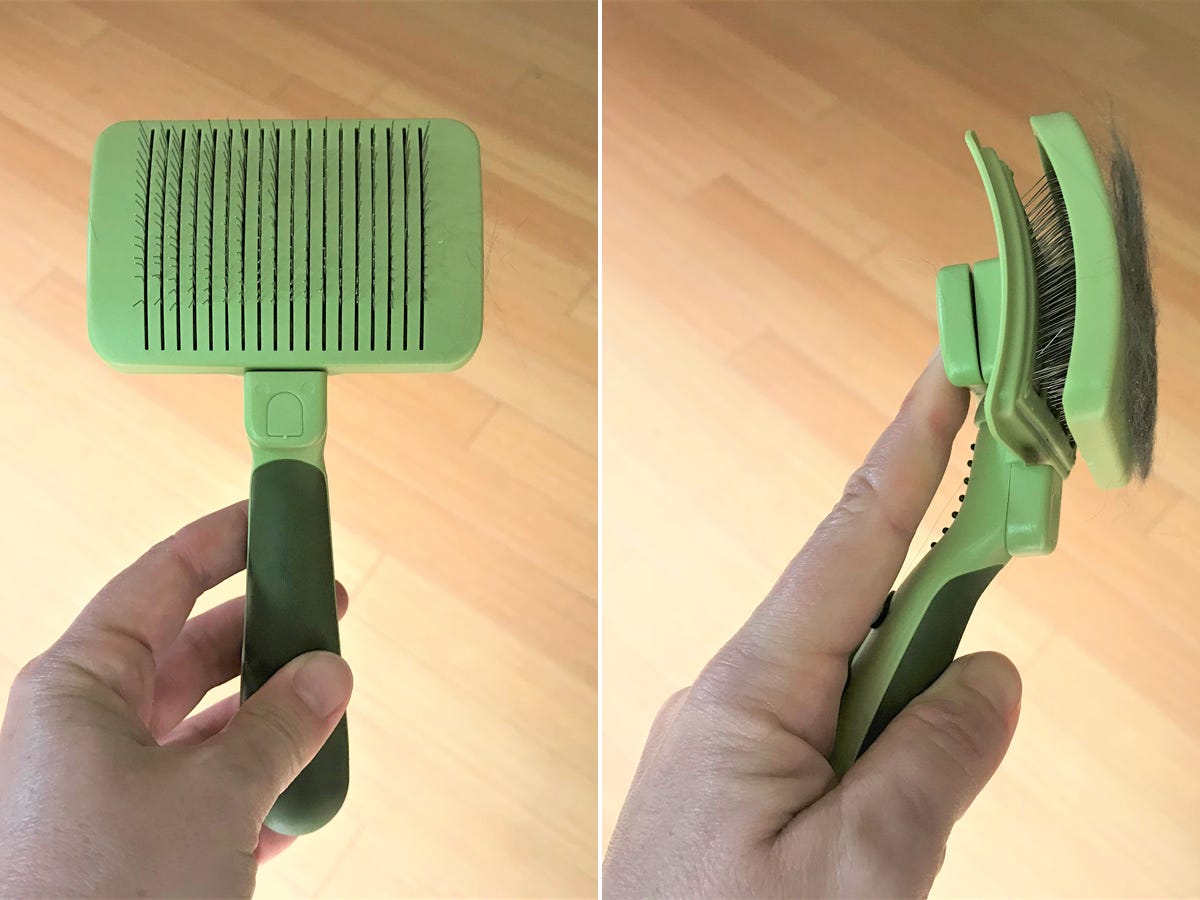
Shoshi Parks/Business Insider
Pros: Self-cleaning design for easy hair removal, ergonomically designed handle with rubber grips, good for removing loose fur and small mats
Cons: May not reach entire undercoat of long-haired cats
"Slicker brushes are often a cat's favorite," says Lioyryan. He says they are particularly useful for removing loose fur from the coat's outer layer and gripping the short strands of a short-haired cat's undercoat. For long-haired cats, a slicker brush is ideal for light daily brushing and catching pin knots, small mats, and loose clumps of fur. The Safari Self-Cleaning Slicker Brush accomplishes all this but stands out for its brush head size and retractable pins.
Safari's lightweight slicker brush has an ergonomic handle with rubber grips. Its 3-by-2-inch paddle with 288 stainless steel pins is agile enough to get into hard-to-reach places. When the pins are full of hair, simply press a button on the back to push the front plate forward and dislodge the hair.
While the brush couldn't remove every mat on a long-haired cat, it did a great job helping us combat those on the chest and under the arms. You'll need to remove tougher tangles with a comb or dematting tool. If your cat's coat is severely matted, it's important to take your cat to a veterinarian or groomer who can safely remove them. "Never try to cut mats out of your cat's hair with scissors," says Simpson. "This can lead to accidental laceration of the skin."
Read our full review of the Safari Self-Cleaning Slicker Brush for cats.
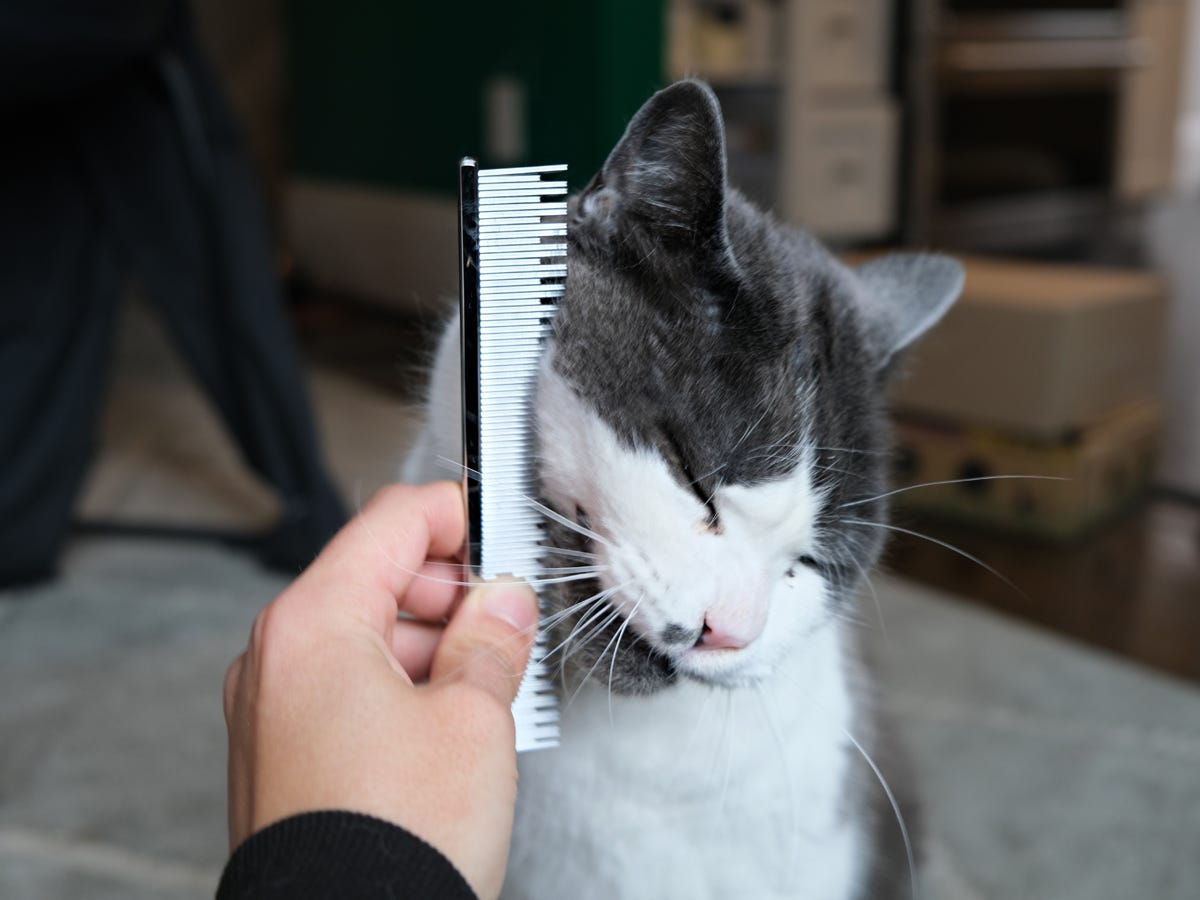
Janelle Leeson/Business Insider
Pros: Dual-length stainless steel teeth, solid brass spine, lightweight, comfortable to use at different angles
Cons: Pricey, only useful for untangling matted fur
Long-haired cats are prone to developing tangled mats in their undercoat, causing discomfort and, in some cases, leading to illness. "Matting causes the hair to pull at the skin, which is painful," says Simpson. At the hind end, urine and feces may also stick to mats, increasing the risk of skin and urinary tract infections.
The best comb to smooth out matted fur is Chris Christensen's Cat/Carding Buttercomb #013, according to Loel Miller, owner of Mobile Grooming by Loel. We found she was right. It excelled at digging into mats and untangling the fur caught within them.
The lightweight comb has stainless steel teeth embedded in a solid 6-inch spine. The teeth alternate in a pattern of long and short tines. The comb has no real handle, just about a quarter-inch-wide ridge that runs its length. It turns out that the lack of a handle makes this comb more versatile and easier to use — it can be held comfortably at any angle to work out tangles.
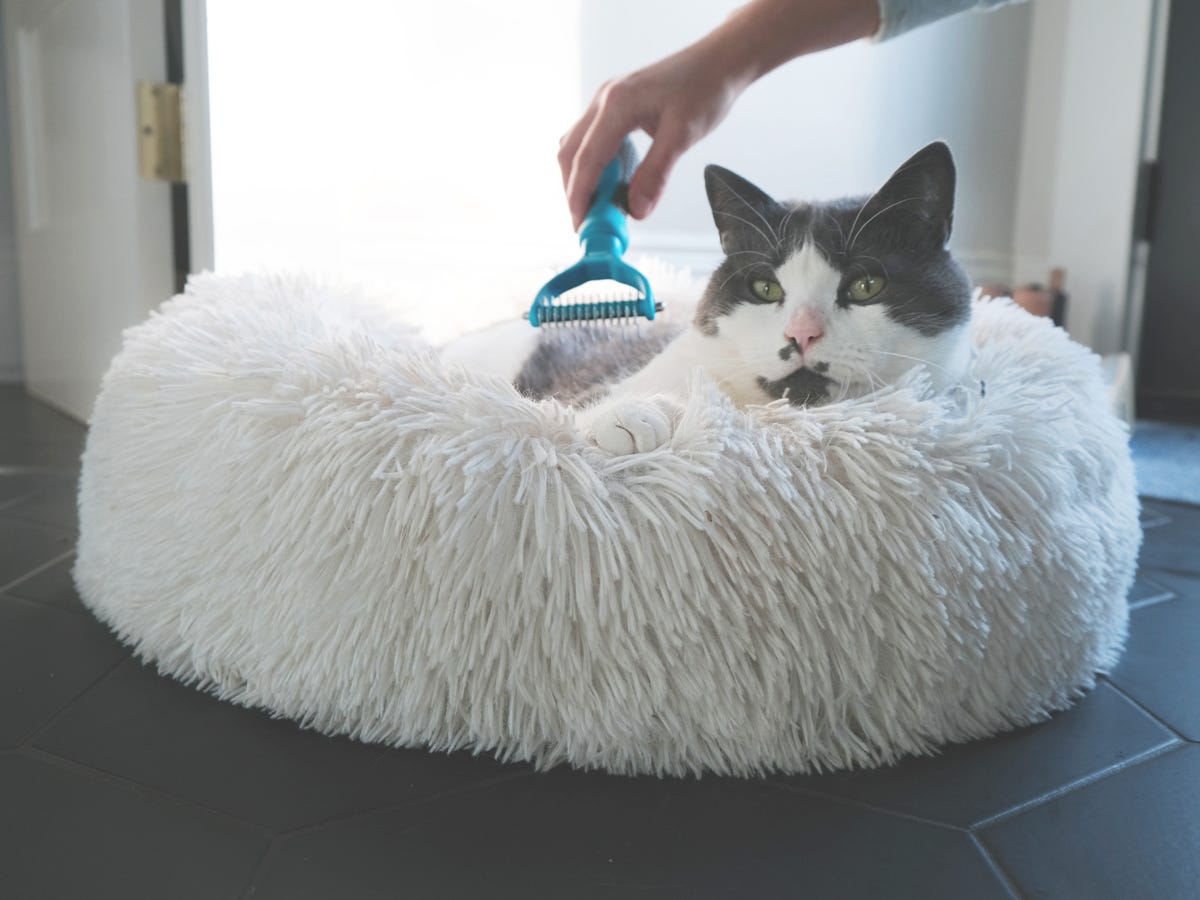
Janelle Leeson/Business Insider
Pros: Two-in-one tool, grips and removes stubborn mats, removes excess fur to prevent future matting, small head to reach nooks and crannies, durable, metal tines
Cons: Pricey
While you can use a comb to remove mats from your long-haired cat, you may find a rake is easier to maneuver. Lioyryan says the best dematting rakes have sharp, curved tines that dislodge mats with minimal pulling. Our top pick, the Well & Good Prostyle Dual-Sided Shedding Rake, stands out for its superior ability to grip and remove pesky mats.
This versatile two-sided tool has an ergonomic handle with rubber grips and a 3-inch wide head. On one side of the head is a seven-toothed dematting tool, and on the other, there is a deshedder with 13 teeth. In one fell swoop, you can turn the tool over in your hand to go from dematting to deshedding, removing excess fur and preventing new mats from forming.
Although our long-haired cat had no stubborn mats during testing, the tool performed well in our simulated dematting tests. We also found it incredibly easy to use the dematting side along our cat's tummy to eliminate tangles, then quickly flip to the deshedding side to thin her fur. While this rake may not remove as much hair as the Andis Deshedding Tool, it effectively clears away loose fur on long- and short-haired cats.
The only downsides are the rake's price and the lack of metal hardware connecting the teeth to the tool. Lioyryans says all-metal hardware will prove the most durable. For a more budget-friendly two-in-one tool, the Maxpower Plant Pet Grooming Brush is a good option, though it's slightly heavier and has a larger head that may prove challenging when removing mats from tight underarm spots.
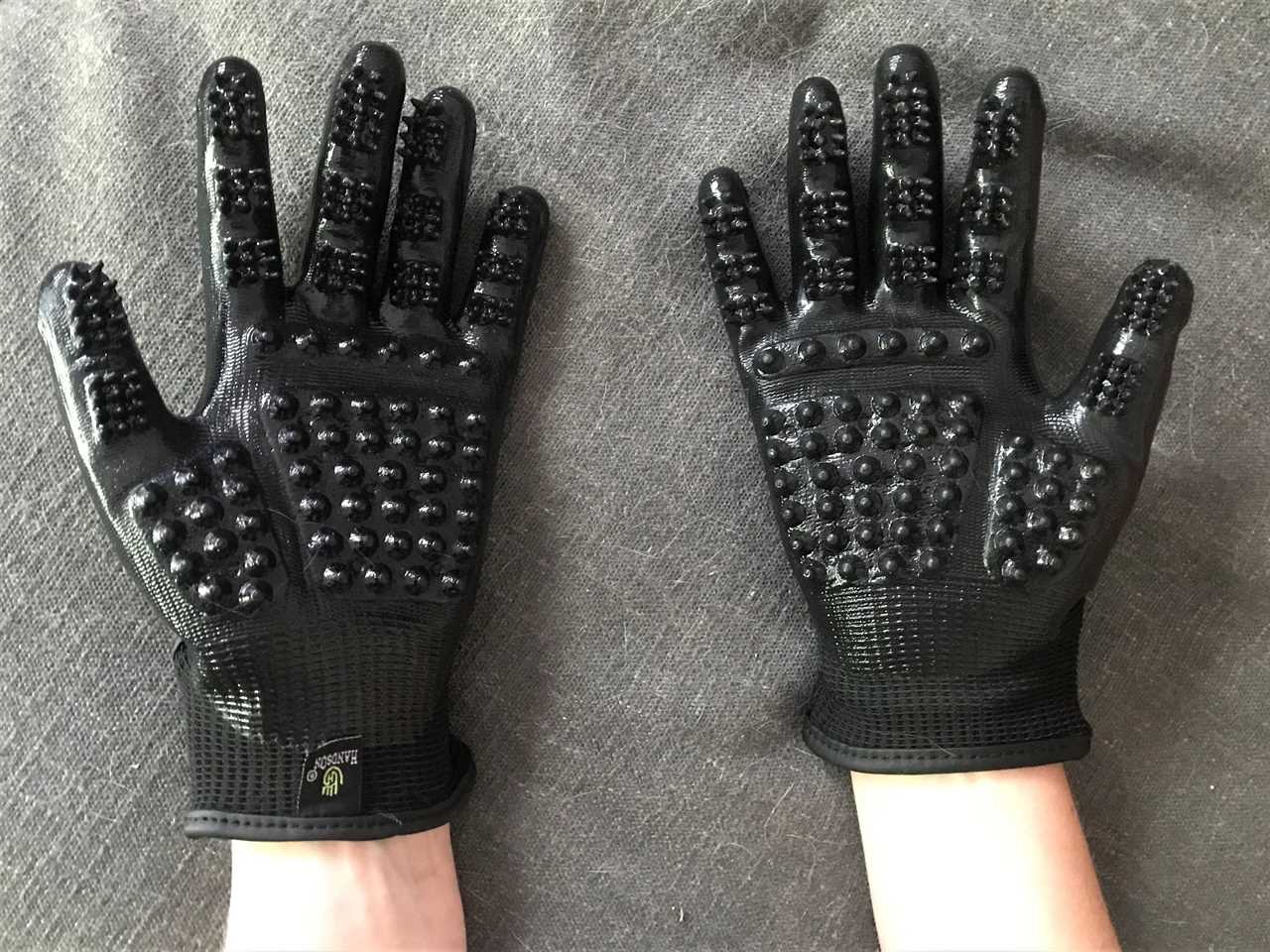
Andy Kindon/Business Insider
Pros: Good for cats who are sensitive to grooming, flexible and comfortable, available in five sizes, can be used wet or dry, good for massage or bathing, durable
Cons: Removes relatively little hair, dirt, and dander compared to other brushes and combs
Cats who refuse to be groomed with a brush or a comb may tolerate grooming gloves, which fit closely to the natural shape of your palm. "Using a grooming glove or a soft rubber grooming brush can acclimate your cat to the feeling of being brushed in a gentle way," says Simpson.
Relative to all of the other brushes and combs we tested, gloves are the worst at removing hair from a cat's coat. However, if your cat is sensitive to brushing, gloves will help remove some fur, dirt, and dander. The well-constructed HandsOn Grooming Gloves were the best of the brands we tested. The rubber palms are covered with rounded nubs, three clumps on each finger and two on the thumb. The other side of the glove is made of strong nylon fabric with a velcro closure at the wrist that secures it snugly.
The gloves come in five sizes, junior to extra large. As an average-sized woman, the medium pair fit me comfortably. Unlike the other gloves we tested, these didn't feel overly bulky. The gloves can be used dry or wet, and so far, they have not cracked, torn, or grown mildew, which the company claims is a feature of their durability.
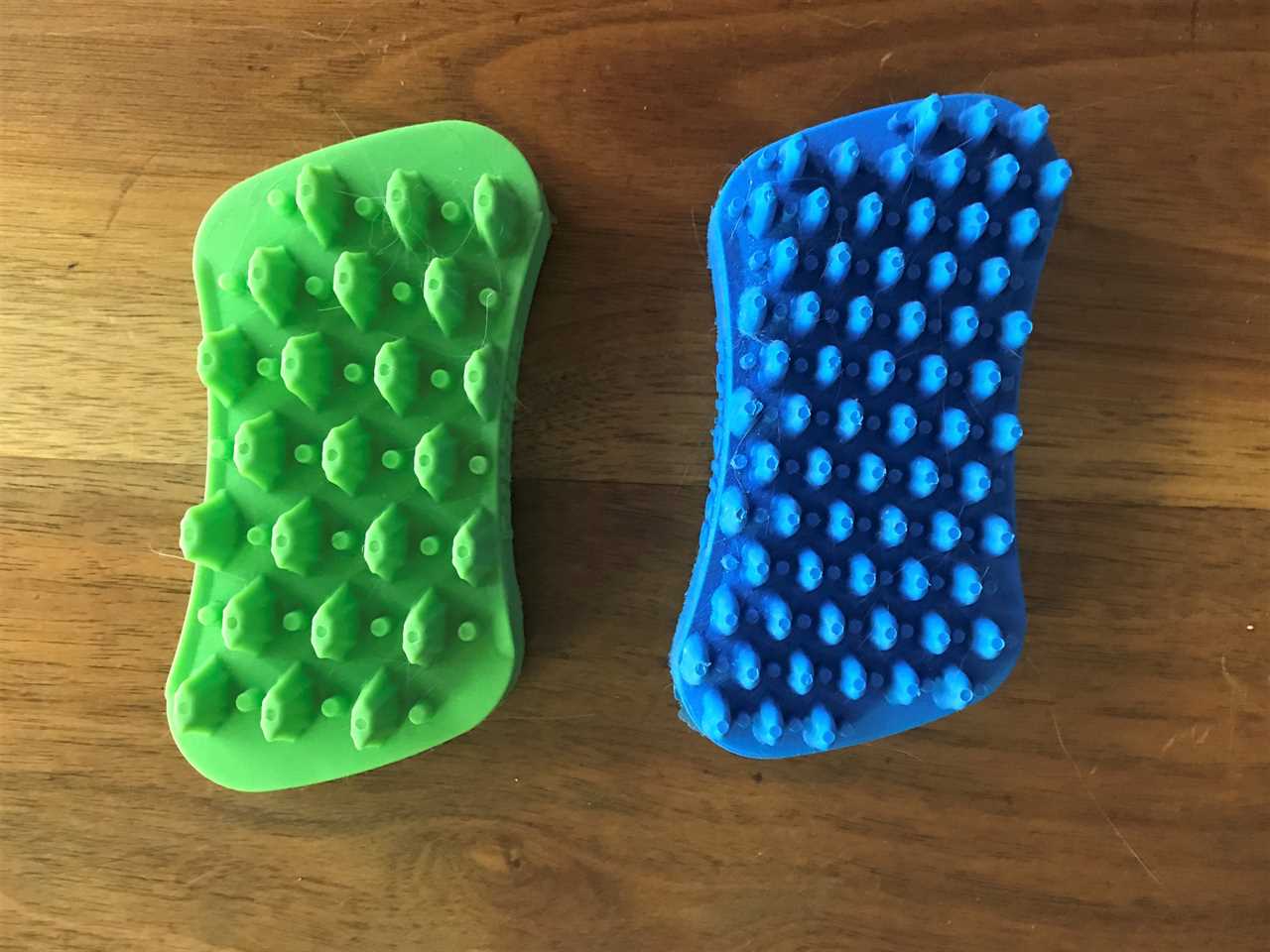
Shoshi Parks/Business Insider
Furbliss for Long Hair Pets
Furbliss for Short Hair Pets
Pros: Medical-grade silicone, multipurpose design, dishwasher and washing machine safe, 100% satisfaction guarantee within 3 months of purchase
Cons: Hair difficult to remove from brush when dry
The Furbliss is one of the best cat brushes not just because its flexible silicone nubs are gentle and effective at removing loose hair but also because you can use it to massage your pet, remove hair from clothing and upholstery, and dispense shampoo in the bath.
A good curry brush is ideal for grooming a short-haired cat, according to pet groomer Melissa Tillman. We found this curry-style brush can help remove loose hair, dirt, and dander from long-haired cats, but it really does shine on cats with shorter hair. The two-sided silicone brush has flexible nodules that smooth out the topcoat and stimulate circulation. The lightweight brush was easy to grip and use. Fur sticks to the silicone material, making it a challenge to clean, but you can rinse it under the faucet or run it through the dishwasher or washing machine. On the back, there are reservoir cells to hold shampoo for deep cleaning while bathing. You can also rub the backside over clothing and upholstery to remove hair and lint.
The Furbliss comes in two different designs. The blue brush has dense, cone-shaped teeth designed for short-haired pets, and the green brush has larger, more widely spaced nubs for long-haired pets. However, we tried both brushes and didn't notice a significant difference.
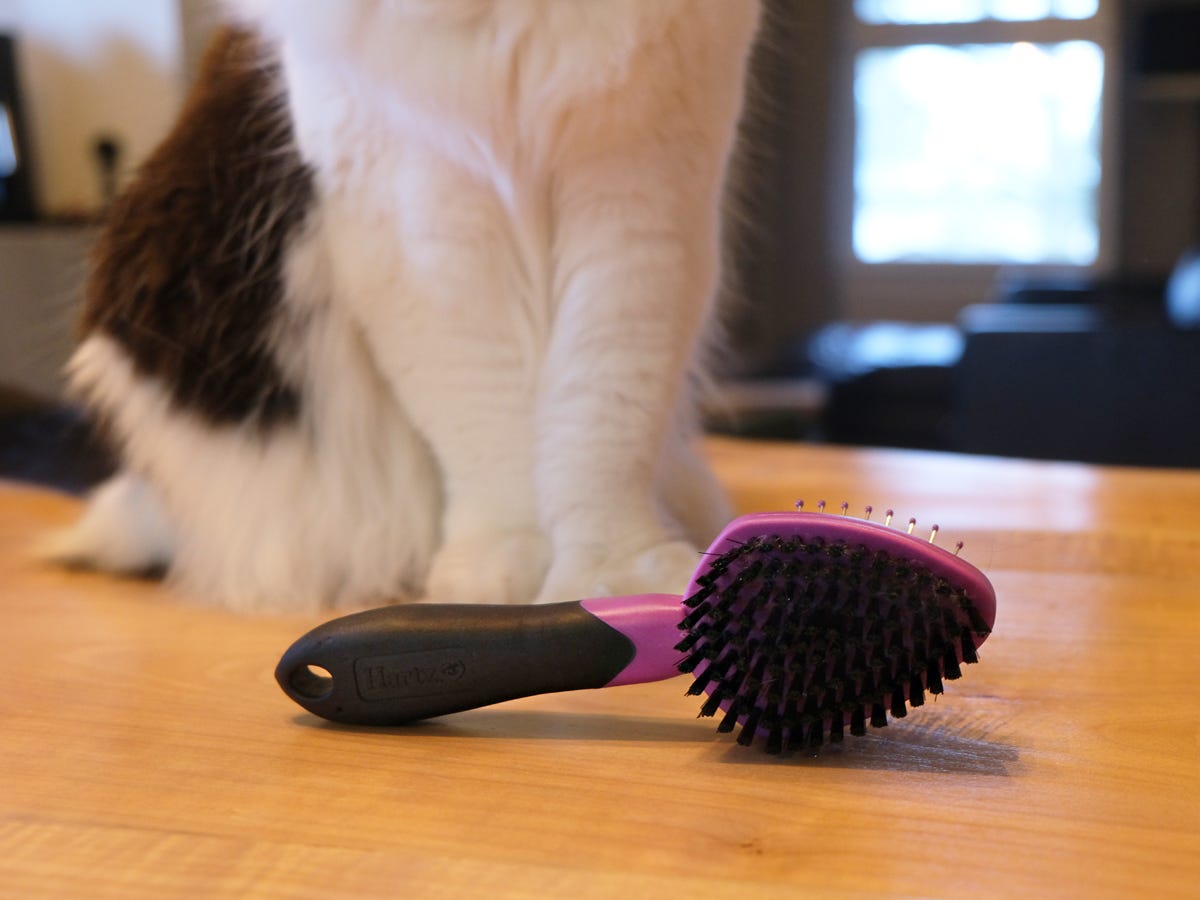
Janelle Leeson/Business Insider
We spoke to three professional groomers and two veterinarians to narrow down the best cat brushes for every coat type and budget. They recommend keeping the following features in mind when shopping for cat grooming tools:
Shape and length: The shape of the brush directly impacts how well the brush removes fur and mats, especially from hard-to-reach places. Dematting and shedding brushes with small heads, like Andis Pet Deshedding Tool and Well & Good Prostyle Dual-Sided Shedding Rake, are great for reaching problematic areas such as under the limbs. The moderate length of the Chris Christensen Buttercomb's teeth angles along the body, effectively tackling tough knots and mats.
Function: Not all brushes serve the same purpose, and you'll need more than one in your arsenal to address all of your cat's grooming needs.
- Pin brushes: These brushes are gentle enough for daily use. The metal tines effectively tackle minor tangles, while the rubber tips provide a gentle, massaging sensation without poking your cat.
- Bristle brushes: The nylon bristles remove loose hair from the topcoat and ensure the rest of the coat is smooth and lying in the same direction, which will help prevent future mats and tangles. A combo pin and bristle brush is particularly suitable for multi-cat households with both short- and long-haired cats.
- Slicker brushes: These are effective for light daily brushing, removing loose fur, and managing small tangles. The metal tines are numerous and slightly bent at the ends, making them especially useful for grabbing loose hairs from the undercoat of short-haired cats.
- Skip tooth combs: This type of comb has a single row of steel tines with alternating lengths, designed to penetrate the undercoat of long-haired cats. If a comb has teeth that are all the same length and closely spaced, you might push the undercoat down instead of effectively brushing through it, says Lioyran. Combs are the ideal weekly or as-needed tool for small mats and grooming following a deshedding.
- Deshedding tools or rakes: These tools have curved times to grip and remove excess fur. The number of tines varies, and Lioyryan says you might need to experiment with several deshedding rakes before finding the one that best suits your cat. He recommends using deshedding rakes monthly or every other month to eliminate loose fur and thin out thick coats. Even short-haired cats require deshedding, given their higher hair follicle count than long-haired cats, according to Lioyryan.
- Dematting rakes: If a stubborn mat pops up, a dematting rake is the best tool. Our experts strongly advise against using scissors on your cat's fur. Lioyryan recommends dematting tools with curved tines rather than straight ones because they tend to have a better grip.
- Grooming gloves: These are gentle enough to acclimate cats to grooming and are less likely to overstimulate cats who are sensitive to touch.
- Curry brushes: These versatile brushes with rubber nubs effectively remove loose hair, massage your pet, remove hair from clothing and upholstery, and lather shampoo during baths.
Comfort: The tines of a brush shouldn't poke and prod at your cat, and a tool should never excessively tug at the fur. To ensure your cat's comfort, opt for a pin brush with rubber-tipped tines and slickers with a soft brush pad that allows the tines to move with the curvature of your cat's bones. The best cat brushes also have ergonomic and rubber handles for the groomer's comfort.
Some cats may still dislike their grooming tools even if they check all the right boxes for comfort. "Just like people, some cats love being brushed, and they tolerate tension on their fur very well. Other cats do not," Lioyryan says. "If a cat doesn't like a particular tool, it doesn't necessarily mean that the tool is wrong." He suggests holding the skin taut to reduce pulling when using a deshedding rake and being mindful when brushing over bones.
Introducing your cat to grooming tools early increases the likelihood that they will tolerate and even enjoy the grooming process. For cats sensitive to grooming, grooming gloves such as HandsOn All-In-One Gloves may be the best option.
To identify the most effective cat brushes and combs for this guide, we conducted the following tests with 31 brushes and combs.
Hair removal test: To objectively compare the brushes in the deshedding tool and slicker brush categories, we used a different grooming tool for one to three days to give our tester cats — two short-haired cats and two long-haired cats — a complete brushing. The removed hair was placed in labeled plastic bags that were laid side by side to reveal which tool removed the most.
Ease of use test: While using each grooming tool, we evaluated the following characteristics:
- How easy the tool was to use overall
- The weight of the tool
- The size of the tool and how well it fit in our hands
- How well the tool accessed hard-to-reach places
- How easy the tool was to clean after use
- The durability of the tool
Dematting test: This test was devised for the products in the dematting comb category. For each comb, we began by rolling, mashing, and entangling a large pile of undercoat fur removed from a long-haired cat using a deshedding tool. We then attempted to restore the fur to its smooth, unmatted state with the comb. The top three tools went on to tackle the small mats on one of our tester cat's chest and under his forelegs, where he has trouble reaching during grooming. The comb that dematted the hair most easily and efficiently was declared the winner.
What is the best brush to use on a cat?
The best brush for your cat depends on their hair type and grooming requirements. A combo pin and bristle brush is the best choice for everyday grooming for both short- and long-haired cats. The pins remove loose hair and small tangles while the bristles smooth the top coat. However, no single brush can fulfill every grooming need. Long-haired cats require grooming with a deshedding rake monthly or every other month, followed by a skip tooth comb or pin brush to remove loose fur and handle small tangles. For bigger knots and mats, you'll also need a dematting tool. If you have a short-haired cat, you can skip the comb but should use a slicker or pin brush to tackle small tangles and remove loose hair from the undercoat. You may also need a deshedding rake and a dematting tool. Some cats may prefer the gentle touch of a soft rubber curry comb rather than a pin or slicker brush. A grooming glove is another good option for short-haired cats, particularly if they are handling sensitive.
Are cat brushes good for cats?
Yes. Brushing a cat removes dead hair and skin cells that would otherwise end up being swallowed while grooming or shedding onto your floor. The less hair a cat consumes, the less likely they are to have regular hairballs. Brushing also distributes the natural oils in the coat to keep it shiny, stimulates blood circulation, and helps a cat and their caregiver bond.
How often should you brush your cat's fur?
Opinions differ even among professionals regarding how often a cat should be brushed. According to the ASPCA, brushing once or twice a week can help keep a cat's coat healthy. VCA Hospitals recommends brushing your cat daily, especially if they have long hair or a thick coat. Tillman's rule of thumb is to brush your cat as often as they will let you, while Harper says he has no rule of thumb but recommends at least running your hands, if not a brush or comb, over your cat's body once daily. Older cats who cannot self-groom may need more regular sessions than younger cats.
How often should I use a deshedding tool on my long-haired or thick-coated cat?
Lioyryan recommends using a deshedding tool on long and short-haired cats monthly to every other month, followed by brushing with a skip tooth comb, slicker brush, or pin brush.
How long should I brush my cat?
Instead of sticking to a set period of time, pay close attention to your cat's body language. If they become agitated or attempt to move away from the brush or comb, call an end to the session and pick it up again later.
How do you brush an unwilling cat?
The earlier you begin to introduce your cat to brushing, the better. "Kittens that are regularly groomed and have their nails trimmed become used to being handled," says Simpson. To set your cat up for brushing success, Simpson recommends positioning them in a comfortable, quiet area and pairing gentle brush strokes or combing with delicious treats. Lickable foods such as Inaba Churu are especially high-value for many cats. To keep your hands free for brushing, you can spread food on a Lickimat or scatter treats in front of your cat. Simpson says cats are less likely to be anxious if you work alone without restraining them.
Should cats go to groomers?
Anytime a cat is heavily matted, it's best to consult a professional. "Cats' skin is easy to cut, so it's best to leave that up to us," says Tillman. If you have a cat who dislikes being brushed, don't hesitate to hire a groomer to do the basics. "It's best not to push the limits of a cat where you are in danger of being injured," says Miller. Cats who are easily stressed during trips to the groomer may benefit from a mobile grooming service that will come to your home.
----------------------------------------------
By: [email protected] (Shoshi Parks,Janelle Leeson,Julie Liu, DVM)
Title: The 7 best cat brushes of 2024, tested and reviewed
Sourced From: www.businessinsider.com/guides/pets/best-cat-brush
Published Date: Tue, 13 Feb 2024 18:27:56 +0000
.png)





